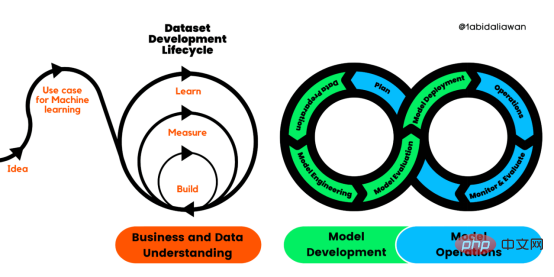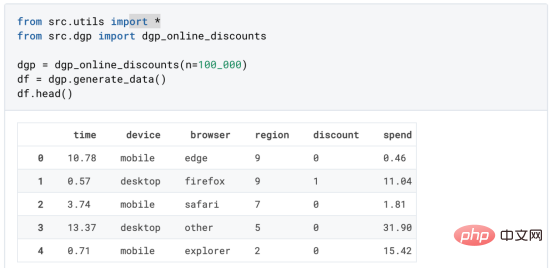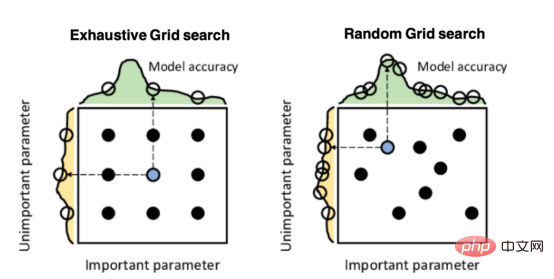Although machine learning has been around since the 1950s, as computers have become more powerful and data has exploded, how can people use artificial intelligence to gain a competitive advantage, improve insights, and grow profits? Extensive practice. For different application scenarios, machine learning and differential equations have a wide range of scenarios.
Everyone has already used machine learning, especially deep learning based on neural networks. ChatGPT is very popular. Do you still need to understand differential equations in depth? No matter what the answer is, it will involve a comparison between the two. So, what is the difference between machine learning and differential equations?
Starting from the differential equation of the love model

These two equations predict the longevity of the couple’s love relationship, based on psychology Based on the seminal work of psychologist John Gottman, the model predicts that sustained positive emotions are a powerful factor in marital success. For more interpretation of the model, you can refer to the book "Happy Marriage". The author also gives 7 rules for maintaining a happy marriage:
- Perfect your love map
- Cultivate affection and praise for your spouse
- Move closer to each other instead of farther away
- Let your spouse influence your decisions
- Start with gentleness and end with compromise
- Learn to live in harmony with problems
- Create common meaning
We have experienced the epidemic personally for three years, and we know what is good and what is good. So, how to use differential equations to describe the relationship between patients and infectious persons?

#The SIR model assumes that viruses are spread through direct contact between infected and uninfected people, with sick people automatically recovering at some fixed rate.
These differential equations all contain the derivatives (ie, the rate of change) of some unknown functions. These unknown functions, such as S (t), I (t) and R (t) in the SIR model, are called the Solutions of differential equations. Based on the mechanics of these equations, we can derive how the model is designed, and the data will later be used to verify our hypotheses.
Classification of mathematical models
Mathematical models like differential equations make assumptions about the basic mechanism of the system in advance. Modeling begins with physics. In fact, the entire field of mathematical modeling begins with The 17th-century quest to unravel the fundamental dynamics behind planetary motion. Since then, mathematically based mechanistic models have unlocked key insights into many phenomena, from biology and engineering to economics and the social sciences. Such mechanism models can be divided into equation-based models, such as differential equations, or agent-based models.

Experience-based or data-driven modeling, such as machine learning, is about understanding the structure of a system through rich data. Machine learning is especially useful for complex systems where we don't really know how to separate the signal from the noise, where simply training a clever algorithm can help solve the problem.
Machine learning tasks can be roughly divided into the following categories:
- Supervised learning (e.g., regression and classification);
- Unsupervised learning (e.g., Clustering and dimensionality reduction) ;
- Reinforcement Learning

Advanced machine learning and artificial intelligence systems are now everywhere in our daily lives No, from smart speaker-based conversational assistants (such as Xiaodu) to various recommendation engines, to facial recognition technology, and even Tesla’s self-driving cars. All of this is driven by mathematical and statistical modeling embedded beneath mountains of code.
Further, these models can be classified as "deterministic" (predictions are fixed) or "stochastic" (predictions include randomness).
Deterministic models ignore random variables and always predict the same results under the same starting conditions. In general, machine learning and equation-based models are deterministic and the output is always predictable. In other words, the output is completely determined by the input.
The stochastic model considers random changes in the population by introducing probability into the model. One way to capture these changes is to make each entity a separate Agent in the model, and define allowed behaviors and mechanisms for these agents, which have certain probabilities. These are Agent-based models.
However, the achievability of modeling individual actors comes at a cost, and agent-based models are more realistic. Due to the high computational cost and the interpretability of the model, this inspired a key concept in mathematical modeling: model complexity.

Model complexity
The dilemma of model complexity is a reality that all modelers must face. Our goal is to build and optimize both A model that is too simple and not too complex. Simple models are easy to analyze, but often lack predictive power. Complex models may be surreal, but it is possible to try to understand the truth behind complex problems.
We need to make a trade-off between simplicity and ease of analysis. Complex machine learning models strive to learn the signal (i.e., the true structure of the system) while rejecting the noise (i.e., interference). This causes the model to perform poorly on new data. In other words, machine learning models are less generalizable.
The delicate act of balancing model complexity is an "art", trying to find a sweet spot that is neither too simple nor too complex. This ideal model washes away the noise, captures the underlying dynamics of what is going on, and is reasonably explainable.
It should be noted that this means that a good mathematical model is not always correct. But that's okay. Generalizability is the goal, being able to explain to an audience why the model does what it does, whether they are academics, engineers, or business leaders.
All models are wrong, but some are useful. ——George Box, 1976
In machine learning and statistics, model complexity is called the bias-variance trade-off. High-bias models are too simple, resulting in underfitting, while high-variance models remember noise instead of signal, resulting in overfitting. Data scientists strive to achieve this delicate balance through careful selection of training algorithms and tuning of associated hyperparameters.
Comparison of Differential Equations and Machine Learning
In mechanism modeling, we carefully observe and review a system before making assumptions about the underlying mechanism of the system. phenomenon, and then validate the model with data. Are our assumptions correct? If so, since it is a hand-picked mechanism, it is entirely possible to explain to anyone what model behaves this way. If the assumption is wrong, that's okay, you just wasted some time, no big deal. Modeling is trial and error after all. Tinker with those assumptions or even start from scratch. Mechanism models, usually equations in the form of differential equations or even agent-based models.
In data-driven modeling, we first let the data start working and build a panoramic view of the system for us. All we have to do is meet the data quality of that machine and hopefully have enough data. This is machine learning. If a phenomenon is difficult for ordinary people to figure out, a machine can be tuned to sift through the noise and learn the elusive signal for us. Standard machine learning tasks include regression and classification, which are evaluated using a range of metrics. Neural networks and reinforcement learning have also become popular, enabling them to create models and learn surprisingly complex signals.
Although machine learning has been around since the 1950s, as computers have become more powerful and data has exploded, how can people use artificial intelligence to gain a competitive advantage, improve insights, and grow? Profits have launched a wide range of practices. For different application scenarios, machine learning and differential equations have a wide range of scenarios.
The above is the detailed content of A brief analysis of machine learning and differential equations. For more information, please follow other related articles on the PHP Chinese website!
 解读CRISP-ML(Q):机器学习生命周期流程Apr 08, 2023 pm 01:21 PM
解读CRISP-ML(Q):机器学习生命周期流程Apr 08, 2023 pm 01:21 PM译者 | 布加迪审校 | 孙淑娟目前,没有用于构建和管理机器学习(ML)应用程序的标准实践。机器学习项目组织得不好,缺乏可重复性,而且从长远来看容易彻底失败。因此,我们需要一套流程来帮助自己在整个机器学习生命周期中保持质量、可持续性、稳健性和成本管理。图1. 机器学习开发生命周期流程使用质量保证方法开发机器学习应用程序的跨行业标准流程(CRISP-ML(Q))是CRISP-DM的升级版,以确保机器学习产品的质量。CRISP-ML(Q)有六个单独的阶段:1. 业务和数据理解2. 数据准备3. 模型
 2023年机器学习的十大概念和技术Apr 04, 2023 pm 12:30 PM
2023年机器学习的十大概念和技术Apr 04, 2023 pm 12:30 PM机器学习是一个不断发展的学科,一直在创造新的想法和技术。本文罗列了2023年机器学习的十大概念和技术。 本文罗列了2023年机器学习的十大概念和技术。2023年机器学习的十大概念和技术是一个教计算机从数据中学习的过程,无需明确的编程。机器学习是一个不断发展的学科,一直在创造新的想法和技术。为了保持领先,数据科学家应该关注其中一些网站,以跟上最新的发展。这将有助于了解机器学习中的技术如何在实践中使用,并为自己的业务或工作领域中的可能应用提供想法。2023年机器学习的十大概念和技术:1. 深度神经网
 基于因果森林算法的决策定位应用Apr 08, 2023 am 11:21 AM
基于因果森林算法的决策定位应用Apr 08, 2023 am 11:21 AM译者 | 朱先忠审校 | 孙淑娟在我之前的博客中,我们已经了解了如何使用因果树来评估政策的异质处理效应。如果你还没有阅读过,我建议你在阅读本文前先读一遍,因为我们在本文中认为你已经了解了此文中的部分与本文相关的内容。为什么是异质处理效应(HTE:heterogenous treatment effects)呢?首先,对异质处理效应的估计允许我们根据它们的预期结果(疾病、公司收入、客户满意度等)选择提供处理(药物、广告、产品等)的用户(患者、用户、客户等)。换句话说,估计HTE有助于我
 使用PyTorch进行小样本学习的图像分类Apr 09, 2023 am 10:51 AM
使用PyTorch进行小样本学习的图像分类Apr 09, 2023 am 10:51 AM近年来,基于深度学习的模型在目标检测和图像识别等任务中表现出色。像ImageNet这样具有挑战性的图像分类数据集,包含1000种不同的对象分类,现在一些模型已经超过了人类水平上。但是这些模型依赖于监督训练流程,标记训练数据的可用性对它们有重大影响,并且模型能够检测到的类别也仅限于它们接受训练的类。由于在训练过程中没有足够的标记图像用于所有类,这些模型在现实环境中可能不太有用。并且我们希望的模型能够识别它在训练期间没有见到过的类,因为几乎不可能在所有潜在对象的图像上进行训练。我们将从几个样本中学习
 LazyPredict:为你选择最佳ML模型!Apr 06, 2023 pm 08:45 PM
LazyPredict:为你选择最佳ML模型!Apr 06, 2023 pm 08:45 PM本文讨论使用LazyPredict来创建简单的ML模型。LazyPredict创建机器学习模型的特点是不需要大量的代码,同时在不修改参数的情况下进行多模型拟合,从而在众多模型中选出性能最佳的一个。 摘要本文讨论使用LazyPredict来创建简单的ML模型。LazyPredict创建机器学习模型的特点是不需要大量的代码,同时在不修改参数的情况下进行多模型拟合,从而在众多模型中选出性能最佳的一个。本文包括的内容如下:简介LazyPredict模块的安装在分类模型中实施LazyPredict
 Mango:基于Python环境的贝叶斯优化新方法Apr 08, 2023 pm 12:44 PM
Mango:基于Python环境的贝叶斯优化新方法Apr 08, 2023 pm 12:44 PM译者 | 朱先忠审校 | 孙淑娟引言模型超参数(或模型设置)的优化可能是训练机器学习算法中最重要的一步,因为它可以找到最小化模型损失函数的最佳参数。这一步对于构建不易过拟合的泛化模型也是必不可少的。优化模型超参数的最著名技术是穷举网格搜索和随机网格搜索。在第一种方法中,搜索空间被定义为跨越每个模型超参数的域的网格。通过在网格的每个点上训练模型来获得最优超参数。尽管网格搜索非常容易实现,但它在计算上变得昂贵,尤其是当要优化的变量数量很大时。另一方面,随机网格搜索是一种更快的优化方法,可以提供更好的
 人工智能自动获取知识和技能,实现自我完善的过程是什么Aug 24, 2022 am 11:57 AM
人工智能自动获取知识和技能,实现自我完善的过程是什么Aug 24, 2022 am 11:57 AM实现自我完善的过程是“机器学习”。机器学习是人工智能核心,是使计算机具有智能的根本途径;它使计算机能模拟人的学习行为,自动地通过学习来获取知识和技能,不断改善性能,实现自我完善。机器学习主要研究三方面问题:1、学习机理,人类获取知识、技能和抽象概念的天赋能力;2、学习方法,对生物学习机理进行简化的基础上,用计算的方法进行再现;3、学习系统,能够在一定程度上实现机器学习的系统。
 超参数优化比较之网格搜索、随机搜索和贝叶斯优化Apr 04, 2023 pm 12:05 PM
超参数优化比较之网格搜索、随机搜索和贝叶斯优化Apr 04, 2023 pm 12:05 PM本文将详细介绍用来提高机器学习效果的最常见的超参数优化方法。 译者 | 朱先忠审校 | 孙淑娟简介通常,在尝试改进机器学习模型时,人们首先想到的解决方案是添加更多的训练数据。额外的数据通常是有帮助(在某些情况下除外)的,但生成高质量的数据可能非常昂贵。通过使用现有数据获得最佳模型性能,超参数优化可以节省我们的时间和资源。顾名思义,超参数优化是为机器学习模型确定最佳超参数组合以满足优化函数(即,给定研究中的数据集,最大化模型的性能)的过程。换句话说,每个模型都会提供多个有关选项的调整“按钮


Hot AI Tools

Undresser.AI Undress
AI-powered app for creating realistic nude photos

AI Clothes Remover
Online AI tool for removing clothes from photos.

Undress AI Tool
Undress images for free

Clothoff.io
AI clothes remover

AI Hentai Generator
Generate AI Hentai for free.

Hot Article

Hot Tools

Atom editor mac version download
The most popular open source editor

mPDF
mPDF is a PHP library that can generate PDF files from UTF-8 encoded HTML. The original author, Ian Back, wrote mPDF to output PDF files "on the fly" from his website and handle different languages. It is slower than original scripts like HTML2FPDF and produces larger files when using Unicode fonts, but supports CSS styles etc. and has a lot of enhancements. Supports almost all languages, including RTL (Arabic and Hebrew) and CJK (Chinese, Japanese and Korean). Supports nested block-level elements (such as P, DIV),

SublimeText3 Linux new version
SublimeText3 Linux latest version

VSCode Windows 64-bit Download
A free and powerful IDE editor launched by Microsoft

ZendStudio 13.5.1 Mac
Powerful PHP integrated development environment







